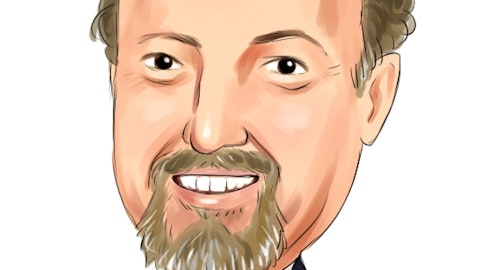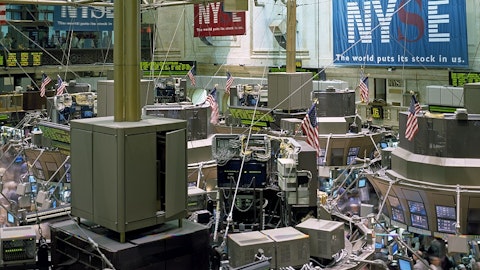Ameet Thakkar: Hi, good evening. Just one question for me. I just wanted to come back to, I guess, the comments earlier on the kind of expectation of free cash flow for entering 2024. I think the expectation was that 4Q was going to be positive free cash flow. And I was just kind of wondering if you could kind of maybe pick a part like was it an expected increase in finished goods inventory or changes in payment terms on the AR balance that caused you, guys, to kind of deviate from that and kind of push that out a little bit further in 2024 with respect to free cash flow generation? Thanks.
Ronen Faier: Sure. So I think it’s the combination of the two. I’ll start by the fact that we needed to extend payment terms. Sometimes we want it. Sometimes we had to extend the payment terms to our customers. We do understand that some of our customers are — do experience a lot of, I would call it, cash difficulties right now because of the fact that if sell-through is lower, they also collect a little bit lower. The fact that we work, by the way, with large customers give us a little bit more confidence in the ability to collect those. But I would say that sometimes, we wanted sometimes we were forced to collect a little bit slower. One interesting phenomenon is that some customers, it’s end of the year, they need to present their financials.
They simply chose to pay instead of the 30th of December. On the third of January, we have those as well. So that was the first part. The second part was, again, the inventory buildup. We had about $200 million of inventory buildup that happened. We — in addition, of course, to the inventory buildup that we saw in Q — in Q4, we usually pay to our vendors in average within 60 days. So not only that we paid for the inventory buildup that happened in Q4, we did quite a lot for some of the buildup that happened in Q3 into the sales of Q4. They did not materialize eventually. So the combination of the two was the end result of what we saw. And I think that it’s mostly the very abrupt stop of revenues — or sorry, reduction in revenues, coupled with the customers, I would call it, inability to pay when needed.
Operator: Thank you. Our next question comes from Austin Moeller with Canaccord.
Austin Moeller: Hi, good evening. My first question here, what is the attach rate that you’re currently seeing for home batteries with inverters in the US versus in Europe?
Zvi Lando: So it obviously varies significantly by country. So Germany attach rates remain in the 80% to 90%. While, in Italy, I’m working off of memory here. So — but it’s in the range of 40% to 50%, 50%. And then as I said before, in the Netherlands, it’s up 10%. If we take these as representative markets in the US — in Europe, excuse me. In the US, it also varies, of course, by market. So in California, overall attach rates right now is about 40% to 50%. But that splits, of course, between some of the remaining NEM 2.0 installations. They don’t necessarily take a battery and the NEM 3.0 that do take a batteries. We mentioned that the sell-through of batteries in the US was up 40-something percent in the fourth quarter. So you can assume that the majority of this is going to California and the attach rate is gradually increasing. In the other states in the US, it’s fairly low. I would, again, off memory, it’s probably in the range of between 10% to 15% or so.
Operator: Thank you. Our next question comes from Vikram Bagri with Citi.
Vikram Bagri: Good afternoon everyone. I apologize, but I wanted to ask one more question about the long-term revenue outlook. Zvi, I think, you mentioned the outlook assumes some market gains. I was wondering if you can highlight the markets where you see market share in opportunity and what the strategy will be to capture that market share? And it doesn’t sound like the second half assumes any inventory restocking, but I wanted to clarify, fourth quarter sort of the outlook $600 million to $650 million does not assume any inventory restocking in any way? And then I have a follow-up.
Zvi Lando: On the first question, I think I discussed there is the topic of new segments that we have entered that we previously didn’t serve at all. And obviously, there, every shipment is a market share gain. And the ground amount now that we’re shipping 300-kilowatt inverters. We’re gaining market share, and the same is in trackers. And same elsewhere from a revenue perspective, the scale is not huge, and we also didn’t include it in the assumptions. In the core markets, share gains are obviously much more incremental. We didn’t — we don’t give specific numbers or expectations or market. We have plans. We didn’t bake them into the assumptions on the sell-through trajectory, leading on into revenue trajectory. Vikram, can you clarify again the second question just to make sure that we understand it correctly.
Vikram Bagri: I was asking the outlook for fourth quarter, $600 million to $650 million does not assume any inventory restocking in any way. I believe it does not, but I wanted to clarify.
Zvi Lando: It assumes that the distribution channel will be by then at the balanced inventory level that they typically want to maintain that historically is somewhere in the range of 60 to 90 days of inventory is what our experience is that most distributors and channels want to hold. So that is kind of what we modeled again a bit variations on countries and regions and products, if that is what — if that helps with the question.
Operator: Thank you. We have no further questions at this time. I now return the call of the conference back over to the presenters.
Zvi Lando: Okay. Just wanted to thank everyone for joining us on the call today, and have a good evening. Thank you.
Operator: This concludes today’s teleconference. You may now disconnect your lines. Thank you for participating.
Follow Solaredge Technologies Inc. (NASDAQ:SEDG)
Follow Solaredge Technologies Inc. (NASDAQ:SEDG)
Receive real-time insider trading and news alerts





